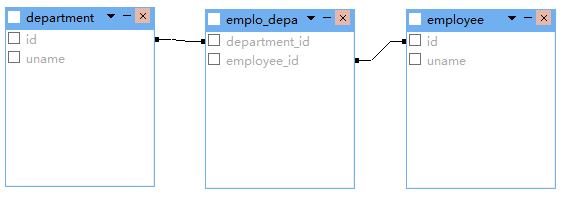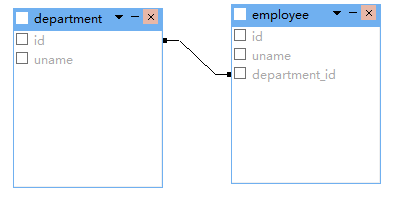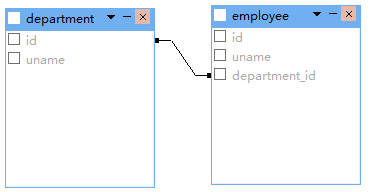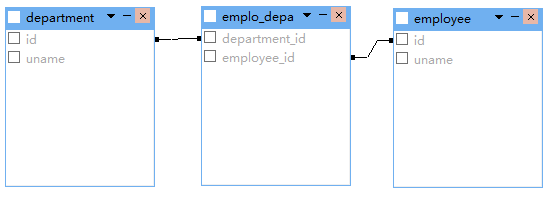如需转载,请说明出处:http://www.cnblogs.com/gudu1/p/6895610.html
Hibernate通过关系映射来表示数据库中表与表之间的关系,关系映射可以通过两种方式:配置文件映射和注解映射,本文主要讲解配置文件映射。
关系映射:
1.单向关联关系,表示只有一方维护关系,而另一方并不知道有这种关系,在解除和删除关联关系的时候也要在有外键方进行,否则会抛出异常,因为有外键的约束。
2.双向关联关系。双方都维护关系,无论在哪一方解除和删除关联关系,Hibernate都能够获知,都能够正确的进行操作。
关系映射中,即使你在类中添加了属性(即相关联的类对象),通过配置inverse属性,也可以设置它是否维护关系,默认为true,可以设置为false表示不维护
一:单向关联
单向多对一:
单向(many-to-one)是最常见的单向关联关系:
<class name="Department" table="department">
<id name="id" column="id">
<generator class="native"/>
</id>
<property name="uname" column="uname" type="string" length="20"></property>
</class>
<class name="Employee" table="employee">
<id name="id" column="id">
<generator class="native"/>
</id>
<property name="uname" type="string" length="20" column="uname"></property>
<many-to-one name="department" class="Department" column="department_id"></many-to-one>
</class>
下面是对应数据库表

单向一对多:
基于外键关联的单向一对多关联是一种很少见的情况,不推荐使用它。
<class name="Department" table="department">
<id name="id" column="id">
<generator class="native"/>
</id>
<property name="uname" column="uname" type="string" length="20"></property>
<set name="employeeSet">
<key column="employee_id"></key>
<one-to-many class="Employee" />
</set>
</class>
<class name="Employee" table="employee">
<id name="id" column="id">
<generator class="native"/>
</id>
<property name="uname" type="string" length="20" column="uname"></property>
</class>
下面是对应数据库表,可以看出跟上面是一样的

单向一对一:
基于外键关联的单向一对一关联和单向多对一关联几乎是一样的。唯一的不同就是单向一对一关联中的外键字段具有唯一性约束(unique)。
<class name="Department" table="department">
<id name="id" column="id">
<generator class="native"/>
</id>
<property name="uname" column="uname" type="string" length="20"></property>
</class>
<class name="Employee" table="employee">
<id name="id" column="id">
<generator class="native"/>
</id>
<property name="uname" type="string" length="20" column="uname"></property>
<many-to-one name="department" column="department_id" class="Department" unique="true"></many-to-one>
</class>
看图好像和(一对多|多对一)结构一样,确实是一样的,你可以插几条数据试一下,因为是一对一关系,有可能会出错的哦!

二:使用连接表单向关联
单向一对多:
基于连接表的单向一对多关联 应该优先被采用。请注意,通过指定unique="true",我们可以把多样性从多对多改变为一对多。
<class name="Department" table="department">
<id name="id" column="id">
<generator class="native"/>
</id>
<property name="uname" column="uname" type="string" length="20"></property>
<set name="employeeSet" table="empl_depa">
<key column="department_id"></key>
<many-to-many column="employee_id" class="Employee" unique="true"></many-to-many>
</set>
</class>
<class name="Employee" table="employee">
<id name="id" column="id">
<generator class="native"/>
</id>
<property name="uname" type="string" length="20" column="uname"></property>
</class>

单向多对一:
基于连接表的单向多对一关联在关联关系可选的情况下应用也很普遍。
<class name="Employee" table="employee">
<id name="id" column="id">
<generator class="native"/>
</id>
<property name="uname" type="string" length="20" column="uname"></property>
<join table="emplo_depa">
<key column="employee_id"></key>
<many-to-one name="department" class="Department" column="department_id"></many-to-one>
</join>
</class>
<class name="Department" table="department">
<id name="id" column="id">
<generator class="native"/>
</id>
<property name="uname" column="uname" type="string" length="20"></property>
</class>

单向一对一:
基于连接表的单向一对一关联也是可行的,但非常少见。
<class name="Department" table="department">
<id name="id" column="id">
<generator class="native"/>
</id>
<property name="uname" column="uname" type="string" length="20"></property>
</class>
<class name="Employee" table="employee">
<id name="id" column="id">
<generator class="native"/>
</id>
<property name="uname" type="string" length="20" column="uname"></property>
<join table="emplo_depa">
<key column="employee_id"></key>
<many-to-one name="department" class="Department" column="department_id" unique="true"></many-to-one>
</join>
</class>

单向多对多:
<class name="Department" table="department">
<id name="id" column="id">
<generator class="native"/>
</id>
<property name="uname" column="uname" type="string" length="20"></property>
<set name="employeeSet" table="emplo_depa">
<key column="department_id"></key>
<many-to-many class="Employee" column="employee_id"></many-to-many>
</set>
</class>
<class name="Employee" table="employee">
<id name="id" column="id">
<generator class="native"/>
</id>
<property name="uname" type="string" length="20" column="uname"></property>
</class>

三:双向关联
一对一双向关联
<class name="Department" table="department">
<id name="id" column="id">
<generator class="native"/>
</id>
<property name="uname" column="uname" type="string" length="20"></property>
<one-to-one name="employee" class="Employee" property-ref="department"></one-to-one>
</class>
<class name="Employee" table="employee">
<id name="id" column="id">
<generator class="native"/>
</id>
<property name="uname" type="string" length="20" column="uname"></property>
<many-to-one name="department" class="Department" unique="true"></many-to-one>
</class>

一对多双向关联
<class name="Department" table="department">
<id name="id" column="id">
<generator class="native"/>
</id>
<property name="uname" column="uname" type="string" length="20"></property>
<set name="employeeSet">
<key column="department_id"></key>
<one-to-many class="Employee" />
</set>
</class>
<class name="Employee" table="employee">
<id name="id" column="id">
<generator class="native"/>
</id>
<property name="uname" type="string" length="20" column="uname"></property>
<many-to-one name="department" class="Department" column="department_id"></many-to-one>
</class>

双向多对一关联把上面权限反转一下就好,这里就不贴代码了。
四:使用连接表双向关联
一对一双向关联
<class name="Department" table="department">
<id name="id" column="id">
<generator class="native"/>
</id>
<property name="uname" column="uname" type="string" length="20"></property>
<join table="emplo_depa" inverse="true" optional="true">
<key column="department_id" unique="true"></key>
<many-to-one name="employee" unique="true" column="employee_id"></many-to-one>
</join>
</class>
<class name="Employee" table="employee">
<id name="id" column="id">
<generator class="native"/>
</id>
<property name="uname" type="string" length="20" column="uname"></property>
<join table="emplo_depa" optional="true">
<key column="employee_id" unique="true"></key>
<many-to-one name="department" unique="true" column="department_id"></many-to-one>
</join>
</class>

多对多双向关联
<class name="Department" table="department">
<id name="id" column="id">
<generator class="native"/>
</id>
<property name="uname" column="uname" type="string" length="20"></property>
<set name="employeeSet" table="emplo_depa" inverse="true">
<key column="department_id"></key>
<many-to-many class="Employee" column="employee_id" ></many-to-many>
</set>
</class>
<class name="Employee" table="employee">
<id name="id" column="id">
<generator class="native"/>
</id>
<property name="uname" type="string" length="20" column="uname"></property>
<set name="departmentSet" table="emplo_depa">
<key column="employee_id"></key>
<many-to-many class="Department" column="department_id"></many-to-many>
</set>
</class>

一对多双向关联
<class name="Department" table="department">
<id name="id" column="id">
<generator class="native"/>
</id>
<property name="uname" column="uname" type="string" length="20"></property>
<set name="employeeSet" inverse="true" table="emplo_depa">
<key column="department_id"></key>
<many-to-many unique="true" class="Employee" column="employee_id"></many-to-many>
</set>
</class>
<class name="Employee" table="employee">
<id name="id" column="id">
<generator class="native"/>
</id>
<property name="uname" type="string" length="20" column="uname"></property>
<join table="emplo_depa">
<key column="employee_id"></key>
<many-to-one name="department" column="department_id" class="Department"></many-to-one>
</join>
</class>

除此之外,还有更多映射配置(继承映射,组件映射),本篇就不写那么多了,希望读者能够查阅文件学习。每天一小步,人生一大步。